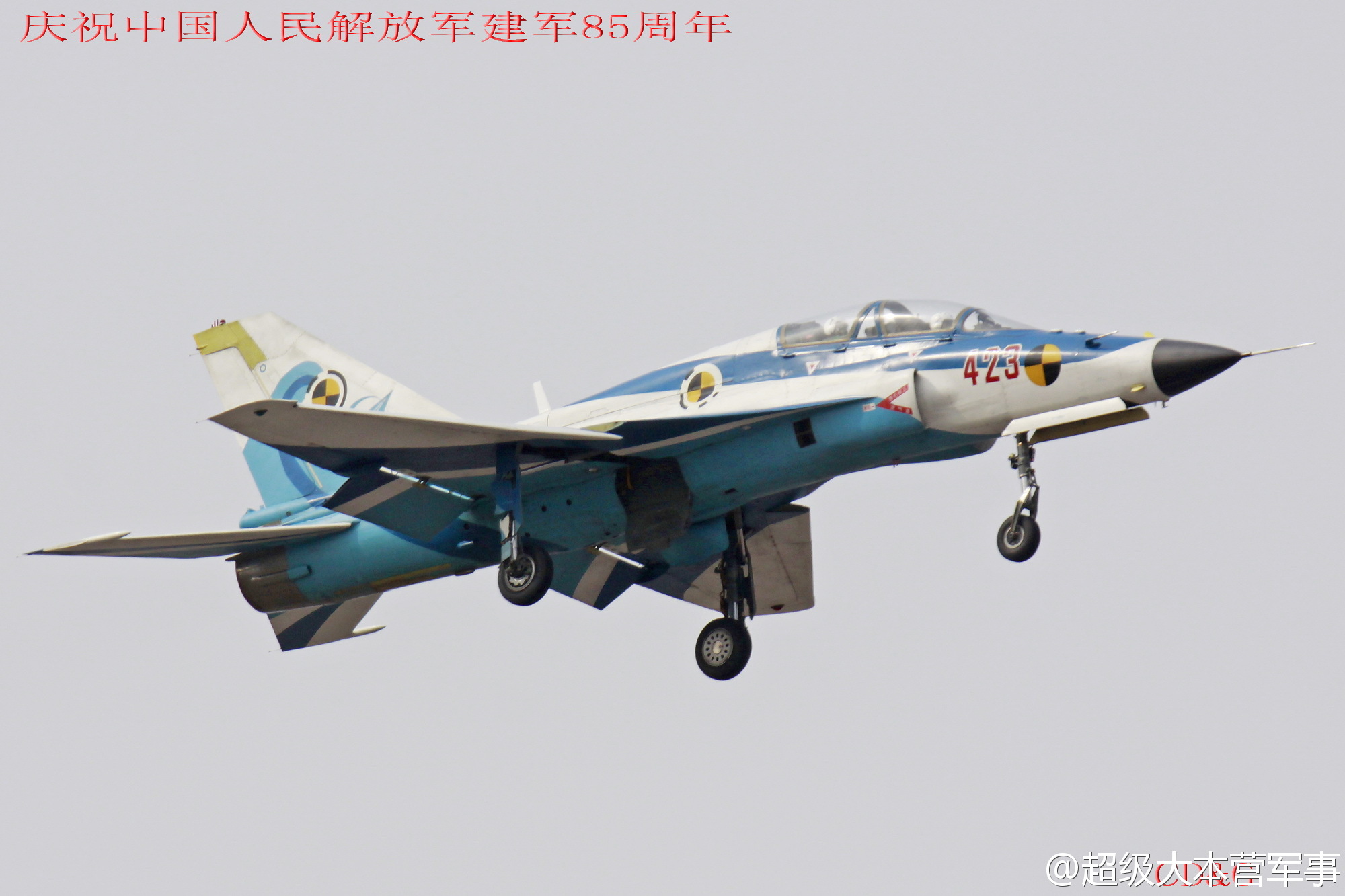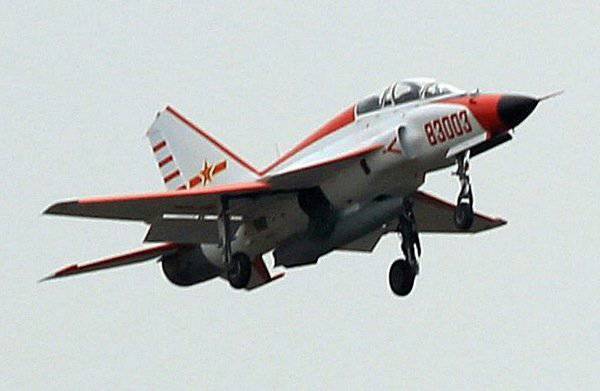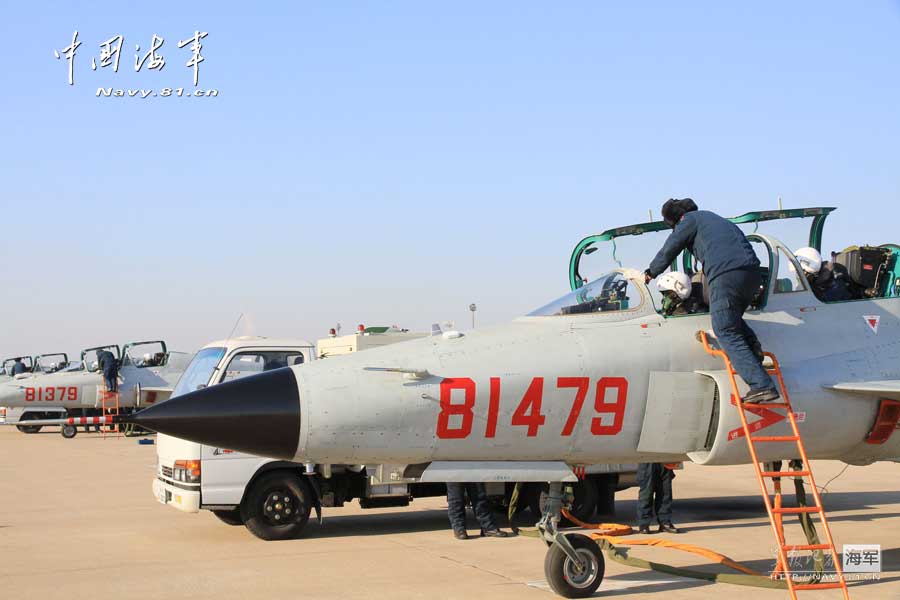




















Guizhou JL-9
From Wikipedia, the free encyclopedia
| GAIEC Guizhou JL-9 | |
|---|---|
 |
|
| Role | Trainer/Attack |
| Manufacturer | Guizhou Aviation Industry Import/Export Company (GAIEC) |
| Designer | Aero Engine Research Institute of Guizhou Aviation Industry Corporation |
| First flight | 13 December 2003 |
| Status | Flight testing, Limited Series Production |
| Primary user | People's Liberation Army Air Force |
| Developed from | JJ-7 fighter trainer |
Development
The GAIEC first revealed its intention to develop a new generation of fighter-trainer to replace its own JJ-7 fighter-trainer at the 2001 China International Aviation & Aerospace Exhibition to meet new PLAAF trainer requirements to prepare pilots for China's newest generation of fighter aircraft such as the Chengdu J-10 and Sukhoi-derived aircraft, such as the Sukhoi Su-27SK, Sukhoi Su-30MKK and Shenyang J-11. The 'FTC-2000' designation indicates an interest in exporting the JL-9 to the international market, likely to countries already operating Guizhou's FT-7 (the export designation for the JJ-7) fighter-trainers. In order to reduce both the development time and development costs of designing an entirely new aircraft, it was decided that the aircraft would be based on the existing Guizhou JJ-7, which itself is based on the Soviet MiG-21U (NATO reporting name "Mongol") fighter-trainer. The JL-9 made its maiden flight on December 13, 2003, only two years after the start of the project, making it the shortest development time for an aircraft in Chinese aviation history, while successfully keeping costs down. In June 2005, Chinese newspapers stated that the JL-9 would be part of the People's Liberation Army's eleventh five-year procurement plan. In 2006, Guizhou reported that five production aircraft have been accepted into PLAAF service.[2][3] Trials continued on the JL-9, and in 2006 an improved JL-9 with a stability control augmentation system and microwave landing system were tested. In September 2009, the JL-9 passed all technology certification tests, which enabled the aircraft to enter series production for both PLAAF and PLANAF.[4]On June 10, 2011, images of the PLANAF version of the JL-9 were revealed for the first time on Chinese state television. The naval version of the JL-9 for advanced carrier training is similar to the PLAAF version, with the exception of four modifications for advanced carrier training: (1) the twin lower nose lateral air intakes were replaced with two smaller mid-air intakes mounted above the front of the main wing to prevent engine stalls when making carrier landing approaches at high angles of attack; (2) for better control at lower landing speeds, the vertical tail surface was redesigned and enlarged; (3) a larger leading-edge extension on the inner section of the main wing was added to enable a low landing speed when landing on a carrier; and (4) the two rear fins (needed only for supersonic stability) were deleted so that a tailhook could be fitted instead. [5] When the PLANAF first revealed their naval version of the JL-9, the first reports in aerospace publications stated that its designation was JL-9H, but later it was revealed that official designation was instead JL-9G. [6][7]
Design
The JL-9's key improvement over its predecessor, the JJ-7, is the redesigned forward fueslage, most notably the replacement of the old inlet cone into a solid nose radome and two lateral air intakes. A new photo emerged August 2011 on Chinese internet websites indicating that the JL-9 has adopted DSI (Diverterless supersonic inlet) design in its latest model, a technology that was previously implemented in the F-35, J-10 and JF-17 fighter jets.[8] [9]The JL-9 uses a tandem, one-piece canopy for the pilot and the instructor (whose seat is designed to be higher than the pilot's to assist their view). The cockpit houses three XPS-2 colour multi-function displays and an avionics suite consisting of Radar warning receiver, Electronic countermeasures, 1553B databus, Inertial navigation system/Global Positioning System and air data computer. The JL-9 can also be fitted with a starboard in-flight refuelling probe. The JL-9 retains the same two-section, double-delta wing without leading edge flaps configuration of the J-7E fighter, which offers greater space for fuel capacity and greatly increases the aircraft's angle of attack compared to a conventional delta wing configuration. The aircraft is built with the J-7E/G fighter's computer-aided design and manufacturing procedure which includes numerical control processing, laser/electromagnetic tests, composite materials, and water jet cutting. In order to reduce costs, the existing WP-13F(C) turbojet engine, fitted with an afterburner from the J-7E/G fighter, is used, providing marked improvement over the JJ-7's WP-7B turbojet engine. Jane's Defence Weekly has reported that the new and much more powerful Liming WP-14C Kunlun-3 turbojet engine will be used for the JL-9 in the future. In another cost-saving move, the JJ-7's mechanical flight control system is also retained. With the introduction of a solid nose radome, the JL-9 is capable of housing a variety of combat radars; for example, the export-designated FTC-2000 is currently being offered with the Italian FIAR Grifo S7 pulse-doppler fire-control radar. The JL-9 has one central and four underwing hardpoints with a total payload of 2000 kg of weapons, including short-range air-to-air missiles, medium-range air-to-air missiles, air-to-surface missiles, bombs, rocket pods and an integrated 23mm cannon. There are also hardpoints for two underwing drop tanks and another drop tank under the fuselage. Unlike many other contemporary fighter-trainer aircraft, the JL-9 is a fighter-sized aircraft, which may lead to the development of an electronic warfare aircraft or a light attack aircraft in the future. In summary, the JL-9 offers a moderate improvement in performance, particularly at lower altitudes, over the existing JJ-7 fighter-trainer.[10][11]
Specifications [12]
General characteristics- Crew: 2
- Length: 14.555 m (47 ft 9 in)
- Wingspan: 8.32 m (27 ft 3.5 in)
- Height: 4.105 m (13 ft 5.5 in)
- Empty weight: 4.96 t (10,935 lb)
- Loaded weight: 7.8 t (17,196 lb)
- Max. takeoff weight: 9.8 t (21,605 lb)
- Powerplant: 1 × Guizhou Liyang WP-13F(C) afterburning turbojet
- Dry thrust: 43.15 kN (9,914 lb)
- Thrust with afterburner: 63.25 kN (14,650 lb)
- Maximum speed: Mach 1.5
- Cruise speed: 1100km/h (594kt)
- Range: 1600 km (863 nm)
- Service ceiling: 16,000 m (52500 ft)
- Guns: 1×Type 23-1 23 mm cannon
- Hardpoints: 5
- Missiles:
- Air-to-air: various short and possibly medium-ranged air-to-air missiles
- Air-to-ground: various
- Bombs: various guided and unguided bombs and rockets
FIAR Grifo S7 pulse-doppler radar
No comments:
Post a Comment